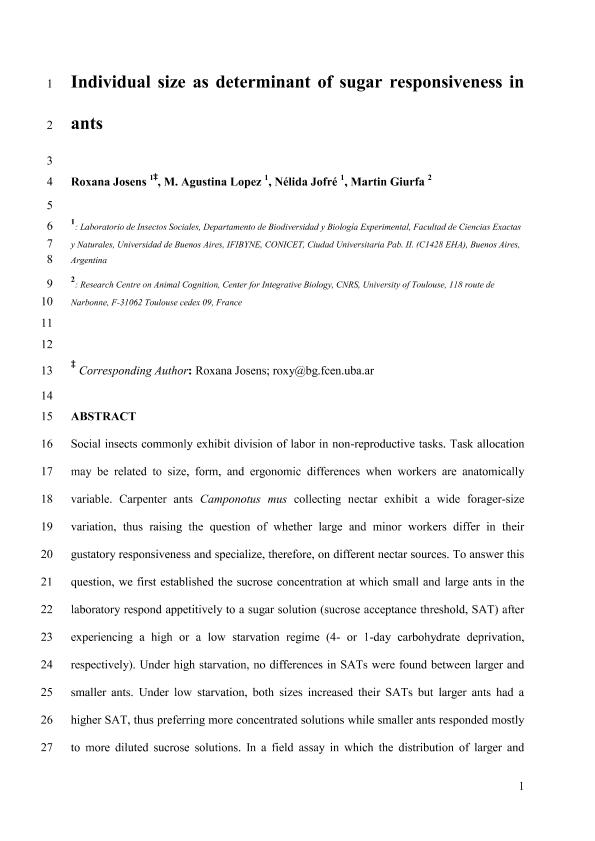Mostrar el registro sencillo del ítem
dc.contributor.author
Josens, Roxana Beatriz

dc.contributor.author
Lopez, M. Agustina
dc.contributor.author
Jofré, Nélida
dc.contributor.author
Giurfa, Martín

dc.date.available
2019-11-11T18:57:05Z
dc.date.issued
2018-10
dc.identifier.citation
Josens, Roxana Beatriz; Lopez, M. Agustina; Jofré, Nélida; Giurfa, Martín; Individual size as determinant of sugar responsiveness in ants; Springer; Behavioral Ecology And Sociobiology; 72; 162; 10-2018; 1-9
dc.identifier.issn
0340-5443
dc.identifier.uri
http://hdl.handle.net/11336/88515
dc.description.abstract
Abstract: Social insects commonly exhibit division of labor in non-reproductive tasks. Task allocation may be related to size, form, and ergonomic differences when workers are anatomically variable. Carpenter ants Camponotus mus collecting nectar exhibit a wide forager size variation, thus raising the question of whether large and minor workers differ in their gustatory responsiveness and specialize, therefore, on different nectar sources. To answer this question, we first established the sucrose concentration at which small and large ants in the laboratory respond appetitively to a sugar solution (sucrose acceptance threshold, SAT) after experiencing a high or a low starvation regime (4- or 1-day carbohydrate deprivation, respectively). Under high starvation, no differences in SATs were found between larger and smaller ants. Under low starvation, both sizes increased their SATs but larger ants had a higher SAT, thus preferring more concentrated solutions while smaller ants responded mostly to more diluted sucrose solutions. In a field assay in which the distribution of larger and smaller ants on sugary food sources was analyzed, small and medium ants were found—in different proportions—at all food sources while larger ants were only found at nectar sources with a higher sugar flow rate, i.e., providing more sugar per unit time. Both field and laboratory assays supported that sugar-related parameters act as determinants of the size distribution of ants among food sources. In addition, interindividual differences in alternative non-sugar-related variables may contribute to this distribution, leading thereby to a potential nectar foraging specialization. Significance statement: Task specialization is crucial for the ecological success of social insects. Carpenter ants allocate individuals of variable size to foraging, thus raising the question of whether they differ in their food preferences. We determined the sugar concentration at which an appetitive response occurs in small and large carpenter ants, and analyzed their distribution on natural and artificial nectar sources in a field assay. Under low starvation, larger ants responded more than smaller ants to higher sucrose concentrations. Coincidently, in the field assay, they were mainly present at sources with higher sucrose delivery. This kind of specialization may reflect the fact that larger ants have larger feeding apparatuses, which may confer a better capacity to deal with the higher viscosity of more concentrated nectars and allow collecting more food at nectaries with higher sugar flow rates. Size specialization may thus increase colony success in the exploitation of variable food sources.
dc.format
application/pdf
dc.language.iso
eng
dc.publisher
Springer

dc.rights
info:eu-repo/semantics/openAccess
dc.rights.uri
https://creativecommons.org/licenses/by-nc-sa/2.5/ar/
dc.subject
CARPENTER ANTS
dc.subject
NECTAR FORAGING
dc.subject
SUCROSE THRESHOLD
dc.subject
WORKER SIZE
dc.subject.classification
Zoología, Ornitología, Entomología, Etología

dc.subject.classification
Ciencias Biológicas

dc.subject.classification
CIENCIAS NATURALES Y EXACTAS

dc.title
Individual size as determinant of sugar responsiveness in ants
dc.type
info:eu-repo/semantics/article
dc.type
info:ar-repo/semantics/artículo
dc.type
info:eu-repo/semantics/publishedVersion
dc.date.updated
2019-10-21T19:13:53Z
dc.journal.volume
72
dc.journal.number
162
dc.journal.pagination
1-9
dc.journal.pais
Alemania

dc.journal.ciudad
Berlin
dc.description.fil
Fil: Josens, Roxana Beatriz. Consejo Nacional de Investigaciones Científicas y Técnicas. Oficina de Coordinación Administrativa Ciudad Universitaria. Instituto de Fisiología, Biología Molecular y Neurociencias. Universidad de Buenos Aires. Facultad de Ciencias Exactas y Naturales. Instituto de Fisiología, Biología Molecular y Neurociencias; Argentina
dc.description.fil
Fil: Lopez, M. Agustina. Consejo Nacional de Investigaciones Científicas y Técnicas. Oficina de Coordinación Administrativa Ciudad Universitaria. Instituto de Fisiología, Biología Molecular y Neurociencias. Universidad de Buenos Aires. Facultad de Ciencias Exactas y Naturales. Instituto de Fisiología, Biología Molecular y Neurociencias; Argentina
dc.description.fil
Fil: Jofré, Nélida. Consejo Nacional de Investigaciones Científicas y Técnicas. Oficina de Coordinación Administrativa Ciudad Universitaria. Instituto de Fisiología, Biología Molecular y Neurociencias. Universidad de Buenos Aires. Facultad de Ciencias Exactas y Naturales. Instituto de Fisiología, Biología Molecular y Neurociencias; Argentina
dc.description.fil
Fil: Giurfa, Martín. Centre National de la Recherche Scientifique; Francia
dc.journal.title
Behavioral Ecology And Sociobiology

dc.relation.alternativeid
info:eu-repo/semantics/altIdentifier/url/https://link.springer.com/article/10.1007/s00265-018-2581-8
dc.relation.alternativeid
info:eu-repo/semantics/altIdentifier/doi/http://dx.doi.org/10.1007/s00265-018-2581-8
Archivos asociados
